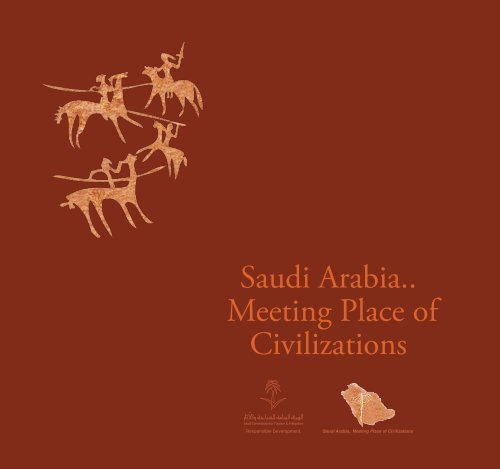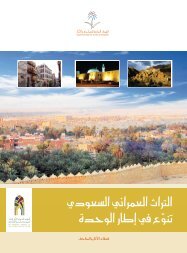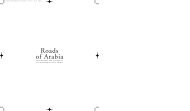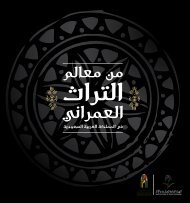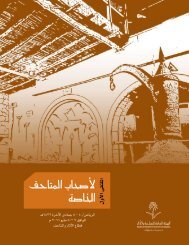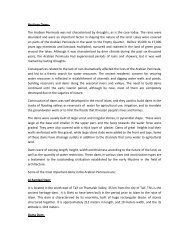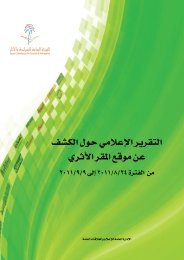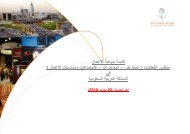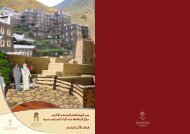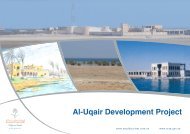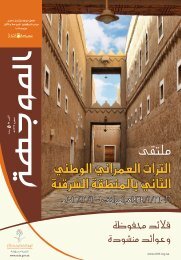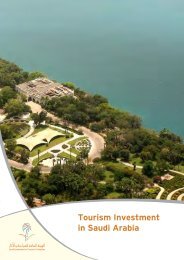Saudi Arabia - Civilization meeting place
Saudi Arabia - Civilization meeting place
Saudi Arabia - Civilization meeting place
You also want an ePaper? Increase the reach of your titles
YUMPU automatically turns print PDFs into web optimized ePapers that Google loves.
<strong>Saudi</strong> <strong>Arabia</strong>..<br />
Meeting Place of<br />
<strong>Civilization</strong>s<br />
<strong>Saudi</strong> <strong>Arabia</strong>.. Meeting Place of <strong>Civilization</strong>s
<strong>Saudi</strong> <strong>Arabia</strong>..<br />
Meeting Place of<br />
<strong>Civilization</strong>s
Introduction<br />
Rock arts, Al-Shuwayhitiyyah<br />
Al-Jawf<br />
The Kingdom of <strong>Saudi</strong> <strong>Arabia</strong><br />
enjoys an eminent position among<br />
the nations of the world. Not only<br />
is it the cradle of Islam and the<br />
land of the two Holy Mosques,<br />
but God has bestowed upon it<br />
immense natural and human<br />
wealth. Furthermore, the Kingdom<br />
plays a major constructive role<br />
in international circles. Along<br />
with its religious, economic, and<br />
political dimensions, the Kingdom<br />
also holds an important cultural<br />
dimension.<br />
Antiquities discovered in the Kingdom demonstrate<br />
that the <strong>Arabia</strong>n Peninsula – of which <strong>Saudi</strong> <strong>Arabia</strong><br />
occupies two-thirds – is one of the oldest areas of<br />
human settlement in the world. Evidence shows<br />
that man settled <strong>Arabia</strong> more than 1.2 million years<br />
ago and, beginning in the fifth millennium BCE, the<br />
inhabitants of the <strong>Arabia</strong>n Peninsula had entered<br />
into far-reaching relations eventually extending<br />
beyond its borders to Mesopotamia, Syria and the<br />
civilizations of the Mediterranean region. At the<br />
same time, these activities engendered an oasisbased<br />
economy ultimately creating large trade<br />
centers.
Meeting Place of<br />
<strong>Civilization</strong>s<br />
Whether one looks to the antiquities associated with the<br />
ancient incense trade, or those connected with the<br />
pilgrimage routes, the <strong>Arabia</strong>n Peninsula repeatedly<br />
emerges as the <strong>meeting</strong> <strong>place</strong> of civilizations over<br />
many centuries. The following can be cited as<br />
examples:<br />
• Madain Salih, a UNESCO World<br />
Heritage Site representing the<br />
ancient Nabatean civilization (300<br />
BCE). The facades of its massive<br />
tombs stand as some of the most<br />
astounding monuments from the<br />
ancient world, and provide evidence<br />
that this land was a transit point.<br />
• A wall 11 kilometers long<br />
surrounded the ancient city of<br />
Tayma, whose history stretches<br />
back to 1200 BCE. In the 6th<br />
century BCE, it was the operational<br />
capital of the Babylonian kingdom<br />
during the reign of Nabonidus.<br />
• There are many prehistoric<br />
antiquities in Tayma, as well as<br />
other artifacts dating back to the<br />
Midianite and Edomite periods at<br />
the beginning of the first millennium<br />
BCE. Antiquities, including<br />
inscriptions from the 6th century<br />
BCE as well as other artifacts from<br />
the early Islamic era, have been<br />
discovered in Tayma. Among the<br />
most significant monuments in the<br />
region are the huge walls, al-Hamra<br />
palace, the Haddaj well, al-Ablaq<br />
palace, and Bujaydi palace.<br />
• Thaj, located in eastern <strong>Arabia</strong> to<br />
the west of the city of Jubayl, was<br />
a station along the caravan route<br />
where passing caravans were<br />
supplied with food and water. The<br />
site of Thaj includes the remains of<br />
a complete city surrounded by walls<br />
with four towers. The center of the<br />
town is characterized by numerous<br />
large tells, and outside of its walls<br />
lay many scattered ancient mounds.<br />
Thaj is also distinguished by its<br />
numerous ancient wells. Results of<br />
preliminary excavations within the<br />
town walls have revealed five main<br />
levels of occupation dated between<br />
500 – 300 BCE.<br />
Part of a hourse head and body,<br />
Al-maqar, 9000 years (BP)<br />
• Finally, the site of the ancient<br />
al-Maqar civilization, which<br />
goes back 9,000 years, was<br />
recently discovered. This area<br />
was inhabited before the last<br />
desertification or during the last<br />
period of climate fluctuations.<br />
Archaeological materials discovered<br />
here demonstrate that the people<br />
of al-Maqar had domesticated<br />
horses and offer evidence of other<br />
domesticated animals, as well as<br />
techniques used in hunting and<br />
farming.<br />
• This discovery confirms that the<br />
horse was domesticated within<br />
<strong>Saudi</strong> <strong>Arabia</strong>n territory in the<br />
heart of the <strong>Arabia</strong>n Peninsula<br />
9,000 years ago. Previous studies<br />
indicate that the horse was first<br />
domesticated in Central Asia 5,500<br />
years ago.<br />
• In the center of the sand dunes of<br />
the Nafud desert in northern <strong>Saudi</strong><br />
<strong>Arabia</strong> is the unique site of Jubbah,<br />
which goes back to the Neolithic<br />
era, 7,000 years ago. The site is<br />
renowned for its unique and prolific<br />
rock art. Registration of Jubbah<br />
within the UNESCO list of World<br />
Heritage Sites is currently being<br />
studied. Jubbah’s history spans<br />
three distinct historical periods, the<br />
oldest of which is known as the<br />
Early Jubbah Period and can be<br />
dated to 7,000 years (BP). Carvings<br />
of humans and animals characterize<br />
this period. Carvings depicting<br />
camels, horses, ibex and date<br />
palms next to Thamudic inscriptions<br />
characterize the second, or<br />
Thamudic, period. Carvings of men,<br />
men riding camels, distinguish the<br />
last, or Late, period and caravans<br />
loaded with goods.<br />
Fine carvings, Jubbah<br />
Large, painted bowl, First half to<br />
mid-1st millennium BC,Tayma<br />
Funerary<br />
Mask,1st century,<br />
Thaj
• Another site that can be dated to the<br />
Neolithic period is al-Shuwaymis,<br />
an important center of civilization in<br />
the north of the <strong>Arabia</strong>n Peninsula.<br />
The site contains exquisite rock art<br />
depicting life-sized humans and a<br />
variety of animals. A magnificent<br />
frieze, which is 12 meters long and<br />
features figures of humans and<br />
animals, was also discovered at the<br />
site.<br />
The mahmal arriving at Mecca, photograph by Halldjian (Royal Geographical Society, London), 1908<br />
Incense burner 4th–1st century BC<br />
Limestone Qaryat al-Faw<br />
Fragment of a wall painting with a banquet scene<br />
1st–2nd century Qaryat al-Faw<br />
• Another remarkable archeological<br />
discovery in the Kingdom of <strong>Saudi</strong><br />
<strong>Arabia</strong> is Qaryat al-Faw (400 – 300<br />
BCE), which has led to the reevaluation<br />
of <strong>Arabia</strong>n archeology<br />
in the centuries prior to the rise of<br />
Islam. Qaryat al-Faw flourished<br />
during the era of the kingdom of<br />
Kindah and excavations there have<br />
revealed rare bronze sculptures, an<br />
exquisite series of fresco paintings,<br />
and a massive edifice carved in<br />
bronze, all of which reveal the<br />
development of life in <strong>Arabia</strong>n cities<br />
along the ancient trade routes<br />
from Yemen across the <strong>Arabia</strong>n<br />
Peninsula.<br />
• After the appearance of Islam - the<br />
last of the revealed religions - in<br />
the 6th century CE, facilities were<br />
constructed along the length of<br />
the routes connecting the city of<br />
Makkah al-Mukarramah to Egypt,<br />
Yemen, Syria, Iraq, and the Islamic<br />
East. Among the most important<br />
<strong>Arabia</strong>n sites associated with<br />
these routes is undoubtedly Darb<br />
Zubaydah (7th century CE). The<br />
Kingdom includes within its territory<br />
a wealth of early Arabic inscriptions<br />
which provides evidence of the level<br />
of learning and the ability to write<br />
by the inhabitants of the <strong>Arabia</strong>n<br />
Peninsula.<br />
Wall fresco decoration, 9th century Al-Rabadha<br />
Map of the pilgrimage roads<br />
Inscribed plaque adorned with ibex<br />
1st century BC - Qaryat al-Faw
Chronology of Successive<br />
<strong>Civilization</strong>s within the Territory of<br />
the Kingdom of <strong>Saudi</strong> <strong>Arabia</strong><br />
Rock Arts, Al-Shuwaymis, Hail
1.PREHISTORIC CIVILIZATIONS<br />
Prehistoric tools<br />
The Paleolithic Age<br />
Material evidence discovered up<br />
to now proves that Paleolithic<br />
settlements existed in the <strong>Arabia</strong>n<br />
Peninsula about 1 million years<br />
BP. An example is the site of al-<br />
Shuwayhitiyyah 30 kilometers<br />
north of Sakaka al-Jawf, where<br />
very primitive stone tools -- mostly<br />
quartz knives and axes -- have<br />
been discovered. This is evidence<br />
of the site’s connection with East<br />
African sites of the pre-Acheulean<br />
period.<br />
The Mesolithic Age<br />
Evidence of human habitation sites<br />
dating back to the Mesolithic Age<br />
50,000 years BP, such as Bit Hima<br />
in Najran Province, has also been<br />
found.<br />
Vessel fragment - Second half of the 3rd<br />
millennium BC - Chlorite - Tarut<br />
The Mousterian<br />
Period<br />
Evidence of Mousterian sites has<br />
been discovered in most parts<br />
of the Kingdom, with numerous<br />
locations in the northern,<br />
northwestern, central, and<br />
southwestern regions, as well as<br />
the eastern region of the Kingdom,<br />
particularly in the northeastern<br />
area of the Empty Quarter around<br />
the Yabrin oasis, dating back to<br />
30,000 years BP.<br />
The Neolithic Period<br />
Sites providing evidence of the<br />
continuation of human settlements<br />
during the Neolithic Period (10,000<br />
years BP) have been discovered.<br />
Among the most important of these<br />
is al-Thumamah, north of Riyadh.<br />
Arrowheads and tools combining<br />
function with art were uncovered<br />
at al-Thumamah, distinguishing<br />
them from Paleolithic and<br />
Mesolithic tools in which function<br />
predominates.<br />
Physical evidence has also been<br />
found confirming the prevailing<br />
belief that human communities<br />
settled in the <strong>Arabia</strong>n Peninsula<br />
9,000 BP, which depended on<br />
breeding mammals and small and<br />
medium sized herds.<br />
The appearance of human<br />
settlements in the Neolithic Period<br />
was accompanied by seasonal<br />
patterns of living, which included<br />
the need to move due to climatic<br />
factors. The centers of these<br />
settlements were in the eastern,<br />
central, northern and western<br />
Beaker c. 5300-4700 BC (Ubaid III)<br />
Painted pottery Khursaniyah<br />
regions and along the numerous<br />
valleys of the <strong>Arabia</strong>n Peninsula.<br />
It appears from archeological<br />
discoveries that communication<br />
existed between these regions,<br />
and that the contacts, which<br />
developed between Eastern <strong>Arabia</strong><br />
and Mesopotamia, exercised a<br />
significant influence during the<br />
Ubaid Period. This may have been<br />
due to movements of settlements<br />
during the pre-pottery period.<br />
Among the distinguishing<br />
features of the Stone Age and<br />
its material cultures are the tools<br />
manufactured from granite flakes<br />
as well as the rock art, which is<br />
widespread, especially in the<br />
northern and central regions.<br />
Perhaps the oldest and largest<br />
example of rock art sites are<br />
Jubbah, which lies 100 kilometers<br />
north of Hail, and al-Shuwaymis,<br />
250 kilometers to its southeast.<br />
Man statue - c. middle of<br />
the 3rd millennium BC -<br />
Limestone Tarut
2. THE DAWN OF CIVILIZATIONS<br />
AND THE BEGINNING OF THE<br />
AGE OF MERCHANTS<br />
“Al-Hamra cube” 5th–4th century BC<br />
Tayma, Qasr al-Hamra<br />
The beginning of external relations<br />
for the <strong>Arabia</strong>n Peninsula occurred<br />
during the Ubaid Period (5400<br />
BCE), when the civilizations of the<br />
peninsula first began to extend<br />
their influence beyond its borders.<br />
During the third millennium BCE,<br />
the first cities began to appear in<br />
the <strong>Arabia</strong>n Peninsula, along the<br />
shores of the <strong>Arabia</strong>n Gulf and<br />
along trade routes. This was a<br />
result of the earlier contacts with<br />
Mesopotamia and the expansion of<br />
international relations, which were<br />
concentrated along the Gulf trade<br />
routes during the fourth millennium<br />
BCE. Dilmun was also a center of<br />
a flourishing civilization, and it is<br />
possible that Sumerian contacts<br />
with Dilmun resulted in a cultural<br />
transformation. There is evidence<br />
to confirm the existence of<br />
historical ties between the <strong>Arabia</strong>n<br />
Peninsula and Mesopotamia.<br />
These relations represented a<br />
high-level system of international<br />
trade on two planes: the provision<br />
of raw materials such as copper<br />
from Oman, and a source of<br />
products of the sea as well as<br />
agricultural commodities. This<br />
relation between the centers<br />
of civilization in <strong>Arabia</strong> and<br />
Mesopotamia and the Indus<br />
Valley was far-reaching. The<br />
ports affiliated with these centers<br />
of civilization distributed trade<br />
goods and engaged in mercantile<br />
contacts between the major<br />
centers, such as Tarut Island and<br />
the Qatif coast.<br />
The first mercantile network<br />
flourished mainly in the eastern,<br />
central, and northwestern regions<br />
of the Kingdom, particularly during<br />
the first millennium BCE. Among<br />
the most important mercantile<br />
cities during that period were<br />
Tayma, Dedan (modern al-Ula),<br />
Thaj, Najran, al-Faw, Dumat al-<br />
Jandal and Midian.<br />
A`midat Arrajajil, AlJawf,<br />
Pre-historic
3.THE AGE OF THE<br />
ARABIAN KINGDOMS<br />
Statue of a man 4th–3rd centuries BC<br />
Red sandstone<br />
256 x 80 cm Al-Ula<br />
Arabs appeared on the stage of<br />
world events at the dawning of the<br />
first millennium BCE. Subsequent<br />
centuries witnessed a whirlwind<br />
of events and intertwined conflicts<br />
in which the <strong>Arabia</strong>n Peninsula<br />
played an important role. The<br />
Arabs entered into wars and<br />
commerce with their neighbors,<br />
as is clear from an Assyrian relief<br />
of 650 BCE. Mercantile relations<br />
between the Near East, the east<br />
coast of Africa, South Asia and the<br />
<strong>Arabia</strong>n Peninsula strengthened<br />
during the first millennium BCE.<br />
Because of its location in the<br />
middle of important trade routes,<br />
the <strong>Arabia</strong>n Peninsula witnessed<br />
Flat, painted bowl First half to mid-1st<br />
millennium BC ,Tayma<br />
the rise of several<br />
Arab kingdoms.<br />
Among them: Edom,<br />
Lihyan and Kindah<br />
all established<br />
kingdoms<br />
along the<br />
major<br />
terrestrial<br />
trade routes<br />
in the <strong>Arabia</strong>n<br />
Peninsula.<br />
In the south<br />
rose the<br />
kingdoms of<br />
Saba, Qataban,<br />
Hadramawt,<br />
Ma`in, and<br />
Awsan, which<br />
engaged in trading<br />
spices and other<br />
products they<br />
produced or<br />
imported from India<br />
and East Africa. Their<br />
kings and queens<br />
built cities and extensive irrigation<br />
systems for their fields and farms,<br />
and directed the incense and<br />
aromatic gums trade from the<br />
southern kingdoms to the regions<br />
of demand such as Iraq, Syria and<br />
Egypt.<br />
Statue of a man, broken<br />
at knee height<br />
4th–3rd centuries BC<br />
Red sandstone<br />
230 x 83 cm<br />
Al-Ula<br />
The Early <strong>Arabia</strong>n<br />
Kingdoms<br />
The cities of the earliest <strong>Arabia</strong>n<br />
kingdoms began to emerge in<br />
different locations on the <strong>Arabia</strong>n<br />
Peninsula, occupying strategic<br />
<strong>place</strong>s along the caravan routes<br />
that joined the peninsula north<br />
to south, and east to west. The<br />
earliest of these cities, known as<br />
the civilization of Midian, appeared<br />
during the second millennium BCE<br />
in the northwestern area of the<br />
peninsula.<br />
The Middle <strong>Arabia</strong>n<br />
Kingdoms<br />
Between the 8th and 4th centuries<br />
BCE, large sections of the <strong>Arabia</strong>n<br />
population transformed into<br />
civilized societies dependent on<br />
agriculture and the caravan trade.<br />
Flourishing cities arose along the<br />
northern caravan routes, such<br />
as Tayma, Dumat al-Jandal, and<br />
Dedan, in addition to the cities of<br />
southern <strong>Arabia</strong>, whose citizens<br />
traded in frankincense and myrrh.<br />
The oasis of al-Ula, which was<br />
known as Dedan, has a wonderful<br />
ancient history as the capital of the<br />
Lihyanite kingdom. It flourished as<br />
a result of its citizens integrating<br />
agriculture into their oasis,<br />
and ingenuity into their trade,<br />
architecture, sculpture, and writing.<br />
The second half of the first<br />
millennium BCE witnessed<br />
competition over control of the<br />
caravan trade between the<br />
Lihyanites and Tayma. The<br />
Lihyanites, whose kingdom lasted<br />
from the sixth to the third centuries<br />
BCE, left inscriptions, temples,<br />
and works of art, which bear<br />
witness to their achievements.<br />
Some monuments at al-Ula were<br />
created by merchants from Ma’in<br />
who came from southern <strong>Arabia</strong> for<br />
trade, and had carved their tombs<br />
in the rock faces overlooking al-<br />
Ula, adorning the most beautiful of<br />
them with carvings of lions.<br />
Rock-cut tomb of al-Aswad<br />
(al-Khurayba sandstone cliffs)
Lihyanite inscription, 5th–2nd<br />
centuries BC, Al-Ula<br />
Mercantile Cities<br />
A number of centers of civilization<br />
continued to flourish along the<br />
<strong>Arabia</strong>n Gulf during the Assyrian,<br />
Babylonian, Achaemenid and<br />
Parthian eras, from the ninth to<br />
the second centuries BCE, and<br />
through the era of the successors<br />
of Alexander the Great, whose<br />
intent was to invade the <strong>Arabia</strong>n<br />
Peninsula. The eastern region of<br />
the <strong>Arabia</strong>n Peninsula witnessed<br />
a period of increasing stability<br />
during the Seleucid era. The city of<br />
Gerrha is the best example of the<br />
high level of prosperity and wealth<br />
attained by towns<br />
in eastern <strong>Arabia</strong> during this time,<br />
and can be compared to that of<br />
certain southern <strong>Arabia</strong>n towns<br />
such as Marib.<br />
The centers of the <strong>Arabia</strong>n<br />
interior were important outposts<br />
along the trading network, which<br />
crisscrossed the Peninsula from<br />
the southwest to the northeast,<br />
ending in southern Mesopotamia.<br />
Many mercantile towns situated<br />
along the route from a point<br />
southeast of Thaj to Qaryat al-Faw<br />
and Thaj, also flourished during<br />
this period for similar reasons.<br />
Among the most important<br />
mercantile towns during the first<br />
and second millennia BCE were:<br />
1. The settlement of Arcomy<br />
in the center of the Jabal<br />
Shammar region.<br />
2. The centers situated<br />
along the length<br />
of Wadi Sirhan,<br />
such as al-<br />
Jawf, which<br />
exercised<br />
its<br />
authority over a wide area of<br />
central and northern <strong>Arabia</strong><br />
during the middle of the first<br />
millennium BCE.<br />
3. Simultaneously, developments<br />
took <strong>place</strong> that led to the<br />
unification of communities on<br />
the Najd plateau, along the<br />
Tuwayq ridge and in Wadi<br />
al-Dawasir. The renowned<br />
kingdom of Kindah took the<br />
city of Qaryat al-Faw as its<br />
trade and political capital.<br />
The Najran site<br />
Gutter” with inscription, c. 2nd century, Najran<br />
4. Najran: Najran witnessed a<br />
long period of settlement at<br />
the site of al-Ukhdud, which<br />
was mentioned in the Holy<br />
Quran (Sura: 85/4). The ruins<br />
of al-Ukhdud are to found in<br />
the village of al-Qabil on the<br />
southern bank of Wadi Najran;<br />
the site is considered one of<br />
the most important ancient<br />
sites in Najran Province.<br />
Age of the Late<br />
<strong>Arabia</strong>n Kingdoms<br />
The <strong>Arabia</strong>n Peninsula was<br />
affected by the violent conflict,<br />
which erupted between the<br />
Byzantine and Sasanian empires<br />
for control of the ancient world. As<br />
a result, the relative stability that<br />
had been enjoyed by the <strong>Arabia</strong>n<br />
kingdoms dissipated and was<br />
re<strong>place</strong>d by turmoil and chaos.<br />
At the same time, the unity of the<br />
kingdom of Kindah in the center of<br />
the <strong>Arabia</strong>n Peninsula collapsed<br />
as <strong>Arabia</strong> turned into a platform for<br />
violent intertribal strife during the<br />
time known as the Jahiliyyah, or<br />
the pre-Islamic era.<br />
Gilt bronze appliqué adorning the bed head,<br />
1st–3rd century, Qaryat al-Faw
known as Darb Zubaydah, the<br />
site of al-Rabadhah north of al-<br />
Madinah al-Munawwarah, and al-<br />
Mabiyyat near the town of al-Ula.<br />
In addition, Fayd in Hail Province<br />
along Darb Zubaydah, sites along<br />
Wadi Hanifah near the city of<br />
Riyadh, al-Dur in al-Ahsa,<br />
and the port of al-Jar near<br />
the town of Yanbu.<br />
Alabaster vessels found at Jerash<br />
near Khamis Mushayt, Asir Region<br />
A stone replica shows the inscriptions of Abraha Al Ashram written in south<br />
Musnad found at Mereghan well in Asir region<br />
4.THE JAHILIYAH PERIOD<br />
In the pre-Islamic period, the <strong>Arabia</strong>n Peninsula was home to a variety of<br />
religions. Alongside the numerous pagan beliefs centered on the worship<br />
of a multiplicity of deities or heavenly bodies such as stars, planets and<br />
the sun, Zoroastrianism, Christianity and Judaism also appeared in<br />
diverse <strong>place</strong>s. Historical sources also mention a group of individuals<br />
who were ‘hanifs.’ People in settled communities worshipped the idols of<br />
their deities in special buildings, while the nomadic Bedouin carried their<br />
gods with them and installed them in special tents in their encampments,<br />
which they considered holy <strong>place</strong>s. Diverse <strong>place</strong>s of worship existed in<br />
the <strong>Arabia</strong>n Peninsula at this time, including mountaintops, caves, special<br />
structures, public squares, tents, and cubic temples.<br />
Shortly before the appearance of Islam, the political situation in the<br />
<strong>Arabia</strong>n Peninsula deteriorated as both the kingdoms of Himyar in the<br />
south and Kindah in central <strong>Arabia</strong> disintegrated<br />
Wooden writing box,<br />
8th–10th century,<br />
Al-Rabadha<br />
Tombstone,10th century, al-<br />
Ma‘la cemetery, Makkah<br />
5. THE ISLAMIC ERA<br />
The appearance of the religion of Islam represents<br />
a watershed in the history of the <strong>Arabia</strong>n Peninsula.<br />
Through the new religion, the unity of the diverse<br />
regions of the <strong>Arabia</strong>n Peninsula was finally achieved;<br />
an Islamic State arose in al-Madinah al-Munawwarah,<br />
which extended its authority to all areas<br />
reached by Islam. Despite the<br />
subsequent transfer of the capital of<br />
the Islamic state to Syria and then<br />
Iraq, the <strong>Arabia</strong>n Peninsula was<br />
not isolated from ongoing cultural<br />
developments, particularly during the<br />
first three Islamic centuries (seventh -<br />
ninth centuries CE). Research has demonstrated<br />
the existence of cities and sites whose history goes<br />
back to the time of the Prophet Muhammad, such as<br />
Juwatha with its famous mosque in al-Ahsa in eastern<br />
<strong>Saudi</strong> <strong>Arabia</strong>, and later in the early Islamic period.<br />
There are numerous writings and inscriptions from<br />
Umayyad and Abbasid times in addition to hundreds<br />
of early Islamic sites along the trade and pilgrimage<br />
routes. Examples of these are the stations and<br />
cisterns to be found all along the pilgrimage route<br />
Many areas of settlement<br />
have also been found in<br />
the southwestern region<br />
of the <strong>Arabia</strong>n Peninsula,<br />
especially near old mines<br />
in mountainous regions.<br />
There are hundreds of<br />
ancient sites that include<br />
dams, such as the dam of<br />
Mu`awiyah in al-Madinah<br />
al-Munawwarah, Sisad Dam<br />
in al-Taif, and Sadd al-Bint in<br />
Khaybar. These are in addition to<br />
springs, wells, fortresses and other<br />
monuments from the early Islamic<br />
period, which demonstrate the<br />
continuation of human and cultural<br />
activity until the appearance of<br />
the First <strong>Saudi</strong> State in Najd,<br />
which extended its hegemony to<br />
encompass most of the <strong>Arabia</strong>n<br />
Peninsula.<br />
Milestone<br />
Late 8th century<br />
Darb Zubayda<br />
Qur`anic manuscript, 16th–17th century
Makkah al-Mukarramah<br />
In the pre-Islamic era, Makkah<br />
al-Mukarramah was known by a<br />
variety of names, including Bakkah<br />
and Umm al-Qura. The history<br />
of the construction of the Holy<br />
Mosque goes back to the late third<br />
and early second millenniums<br />
BCE, when the Prophet Abraham<br />
and his son Ismail built it.<br />
Makkah was founded by Abraham<br />
and Ismail in obedience to the<br />
order of God, to be a <strong>place</strong> for His<br />
worship, but the <strong>Arabia</strong>n tribes<br />
gradually transformed this original<br />
monotheism into polytheism, and<br />
filled the Haram with their idols.<br />
From the time of the Prophet<br />
Abraham, the Arabs traveled to<br />
Makkah annually from all parts of<br />
<strong>Arabia</strong> to perform the rites of the<br />
pilgrimage. Gradually, Makkah<br />
developed into a flourishing<br />
intellectual, cultural and mercantile<br />
center and became famous for<br />
its summer and winter caravan<br />
journeys to Syria and Yemen.<br />
Al-Madinah<br />
al-Munawwarah<br />
Before Islam, Yathrib was an<br />
extensive oasis in which there<br />
were numerous residential<br />
quarters, fortresses and farms, but<br />
no centralized city as such. When<br />
the Prophet Muhammad emigrated<br />
to it, he purchased the site where<br />
his camel knelt down – upon the<br />
order of God – and thereupon<br />
constructed his mosque, which<br />
became the center of a new city.<br />
The Prophet’s Mosque in al-<br />
Madinah al-Munawwarah occupies<br />
a special <strong>place</strong> among all the<br />
mosques of the world, for it is<br />
the mosque originally built by the<br />
Prophet Muhammad himself. It<br />
came to be known as the second<br />
of the three Holy Mosques to which<br />
Muslims journey, and for which<br />
their hearts yearn to visit.<br />
The Prophet’s Mosque was the<br />
center of the administration of<br />
the early Islamic state and for<br />
the teaching of Islam during the<br />
lifetime of the Prophet Muhammad<br />
and the Four Rightly Guided<br />
Caliphs after him, during whose<br />
era al-Madinah al-Munawwaran<br />
remained the capital.
6. THE RISE OF THE FIRST SAUDI STATE<br />
IN AL-DIRIYYA`H AND THE SECOND SAUDI<br />
STATE IN RIYADH<br />
Abdulaziz’s troops in central <strong>Arabia</strong>,<br />
photograph by Captain Shakespear in 1910–11,<br />
Royal Geographical Society, London<br />
A palace in Atturif District in Historic<br />
Addiriya`h<br />
At the beginning of the 12th<br />
century of the Hijrah (18th century<br />
CE), the First <strong>Saudi</strong> State was<br />
founded in al-Diriyya`h by the<br />
Imam Muhammad Ibn Saud. His<br />
rule began in AH 1139/1726 and<br />
developed into a flourishing and<br />
stable state.<br />
In AH 1231/1816, Muhammad<br />
Ali Pasha, the ruler of Egypt on<br />
behalf of the Ottoman Turks,<br />
dispatched his son Ibrahim Pasha<br />
to Najd in order to destroy the<br />
<strong>Saudi</strong> state. Ibrahim Pasha arrived<br />
at al-Diriyya`h with his forces in<br />
AH 1233/1818 and proceeded<br />
to attack the town. Although its<br />
inhabitants resisted with all the<br />
means at their disposal, Imam<br />
Abdallah Bin Saud was compelled<br />
to surrender to avoid further loss<br />
of life.<br />
From AH 1238/1820 until AH<br />
1240/1822, the town of Riyadh,<br />
by virtue of its excellent defensive<br />
capabilities and the destruction<br />
that had been inflicted upon al-<br />
Diriyya`h, came into prominence. It<br />
became the capital of the Second<br />
<strong>Saudi</strong> State under the leadership<br />
of Imam Turki Bin Abdallah
7. THE ESTABLISHMENT OF THE MODERN<br />
KINGDOM OF SAUDI ARABIA<br />
After he left Riyadh in AH<br />
1309/1891, King Abdulaziz lived<br />
in the desert for seven months,<br />
during which time he learned the<br />
prized skills of the <strong>Arabia</strong>n tribes<br />
and became acquainted with their<br />
way of life. He grew accustomed<br />
to bearing the hardship of life in<br />
the desert with its unceasing travel<br />
on camelback. King Abdulaziz<br />
developed his ability to bear<br />
hardship and learned patience<br />
when confronted with hunger and<br />
thirst and a life without any sort<br />
of convenience. The lessons he<br />
learned served him well when<br />
he sought to capture the town<br />
of Riyadh. On the morning of<br />
Thursday 5 Shawwal AH 1319,<br />
(14 January1902), King Abdulaziz<br />
and his companions attacked and<br />
captured the Masmak fortress in<br />
Riyadh. This was the first step in<br />
the recapture of Riyadh, the return<br />
of the rule of the Al Saud, and the<br />
beginning of the process of the<br />
unification of the Kingdom of <strong>Saudi</strong><br />
<strong>Arabia</strong>.<br />
The Kingdom of <strong>Saudi</strong> <strong>Arabia</strong> was<br />
established by King Abdulaziz Bin<br />
Abd al-Rahman Al Saud in AH<br />
1351/1932 after he had completed<br />
the unification of the <strong>Arabia</strong>n<br />
Peninsula from north to south and<br />
east to west, with its capital in<br />
Riyadh.<br />
King Abdulaziz in Riyadh<br />
returning<br />
from Friday prayer,<br />
photograph by De<br />
Gaury in 1939, Royal<br />
Geographical Society,<br />
London<br />
Al-Masmak Fort
www.scta.gov.sa


